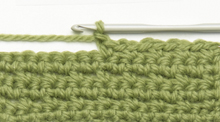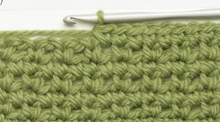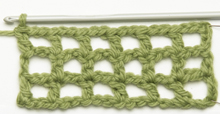Learning how to combine chain stitches with skipping stitches to create spaces (or holes) is your next step to creating fashion details like buttonholes and drawstrings, and the wonderful array of pattern stitches that we are sure you’ll want to tackle. Here are two exercises for you to practice and get comfortable with the techniques.
EASY EYELETS
Eyelets are holes that are made by chaining, then skipping the same amount of stitches that were chained. The evenly spaced holes can be used for weaving in a drawstring or ribbon, fastening buttons, or can stand on their own as pretty, peekaboo pattern stitches. Making them is easy, but keeping the length of the chain stitch the same width as the single crochet stitch can be a little tricky, so practicing is highly recommended.
eyelets

1. For your practice swatch, chain eighteen. Work one single crochet in the 2nd chain from the hook, then work one single crochet in each of the remaining sixteen chains—seventeen single crochet stitches. Chain one and turn. Work one single crochet in the first stitch, *chain one, skip the next stitch, then work one single crochet in the next stitch. Repeat from the * to the end of the row. Chain one and turn.

2. Work one single crochet in the first stitch, *work one single crochet in the next chain-one space, then work one single crochet in the next stitch. Repeat from the * to the end of the row. Chain one and turn. Continue to alternate rows as established until you feel comfortable with the technique and your chain stitches/spaces and single crochet stitches are all uniform in size.
MAKE IT MESH
Mesh patterns are like eyelet patterns, only the holes are bigger. Here you will learn to do a simple double crochet pattern with chain-two spaces. Once you grasp the concept of chaining and turning (what the numbers mean here) and where to work the last stitch of the rows, you will have the skill to undertake other openwork patterns. You will also get a leg up on doing other methods of crocheting, like working in the round.
mesh

1. For your practice swatch, chain twenty-three. Work one double crochet in the 8th chain from the hook. (Note: Three of the seven chains that were skipped count as one double crochet stitch. Two chains are for the first chain-two and the other two chains equal two skipped chains.) Continue as follows: *Chain two, skip the next two chains, work one double crochet in the next chain. Repeat from the * four more times. Chain five and turn. (Note: Three of the five chains count as one double crochet stitch and two chains are for the first chain-two.)

2. Skip the first stitch *work one double crochet in the next stitch, chain two. Repeat from the * four more times. Here’s where you’ll see how these turning chains form a stitch and spaces. To end the row, skip the next two chains of the seven skipped chains of the row below. Work the last double crochet stitch in the 3rd chain. See how the five remaining chains (one double crochet and two skipped chains) form a corner that looks just like the opposite corner. However, a typical pattern stitch would not tell where to work the last stitch as just described. It would state: Double crochet in the 5th chain of the chain-seven. To continue, chain five and turn. (Note: Three of the five chains count as one double crochet stitch and two chains are for the first chain-two.)

3. Skip the first stitch *work one double crochet in the next stitch, chain two. Repeat from the * four more times. Skip the next two chains of the five turning chains of the row below. Work the last double crochet stitch in the 3rd chain (or, double crochet in the 3rd chain of the chain-five). To continue, chain five and turn. To continue, repeat from the beginning of this step until you feel comfortable with the technique.
